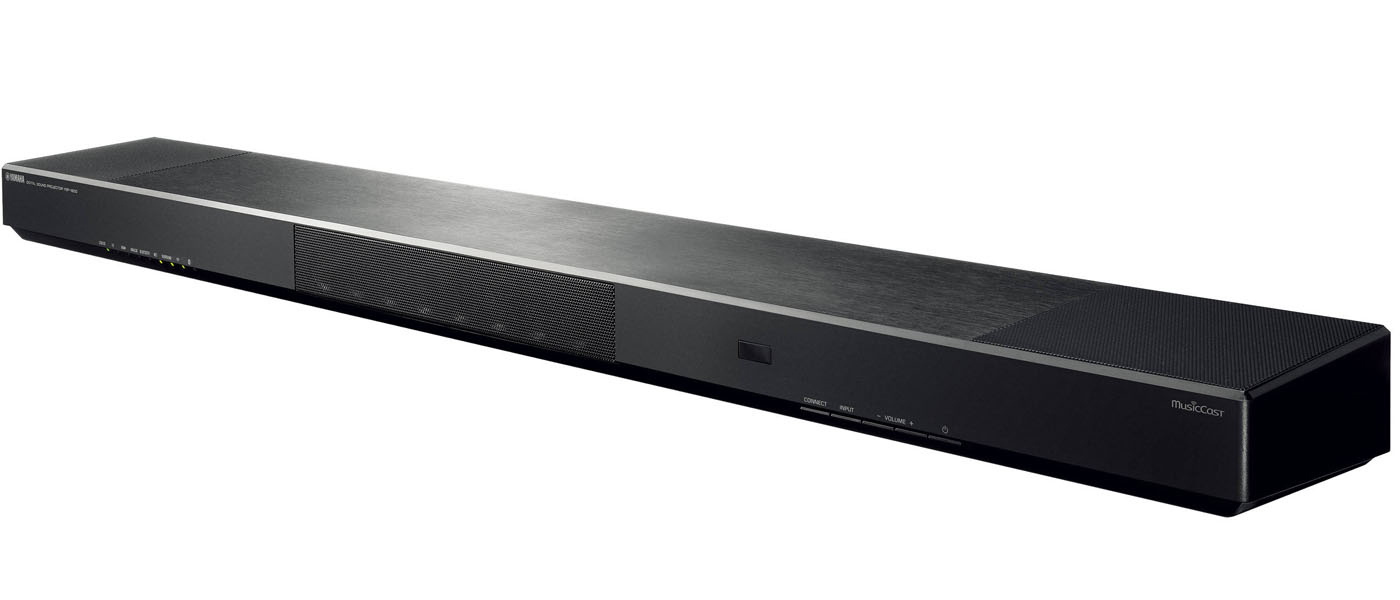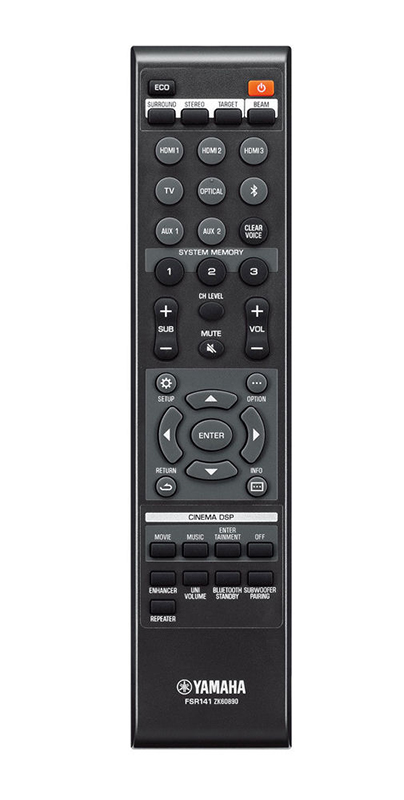The YSP-2500 features sixteen beam drivers powered by sixteen amplifiers and Dolby True HD and DTS-HD Master Audio processing, as well as Bluetooth aptX for streaming from your smartphone or tablet.
Secrets of Home Theater and High Fidelity has long been a leader in reviews of a wide range of home theater and audio gear. This review covers the brand new sound bar which falls near the top of Yamaha’s extensive line of sound bars and the new speaker base. The YSP-2500 offers a host of the latest technology for home theater including support for 4K Ultra HD 50/60p pass-through and 3D via three HDMI inputs, Dolby True HD and DTS-Master Audio processing, aptX Bluetooth streaming and a wireless powered subwoofer, to name just a few. It also features Yamaha’s IntelliBeam auto calibration system for optimizing the sound bar to your room.
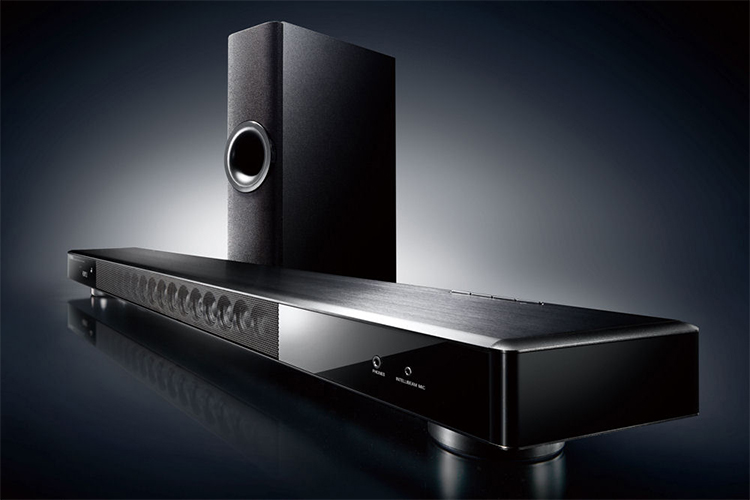
YAMAHA YSP-2500 SOUND BAR
- 4K Ultra HD 50/60p pass-through and 3D on HDMI inputs
- Dolby True HD and DTS-HD Master Audio Processing
- Wireless Powered Subwoofer
- Built-in Bluetooth aptX Streaming
- Stylish Design with Solid Aluminum Chassis and Solid Aluminum Top
- Intellibeam Auto Room Calibration
- TV Remote Repeater for Signal Transmission
- Surround Capability Varies With Room Configuration
- Auto Calibration May Not Work in Some Rooms
I must admit at the onset that I am not a big fan of sound bars in general. My reason for this is twofold: first, I think that for the cost of one of the better sound bars, such as the Yamaha YSP-2500, one can put together a decent 2.1 or 3.1 speaker system, along with an entry-level AV receiver (Yamaha has that covered), that sounds better and offers more flexibility than a sound bar; second, the sound bars I have heard in the past, some costing under $100, sounded little better than the TV’s built-in speakers. Of course, being single, I am not concerned with keeping a spouse happy about the large tower speakers looming at the four corners of my living room and two in my master bedroom.
Design:
7.1 Channel Surround Sound Bar and Wireless Active Subwoofer
Output Channel:
7.1-Channel
Output Power:
162 W Total Power: 2 W x 16 Beam Drivers + Dynamic 130 W Subwoofer
Power Consumption:
25 W (Center Unit) , 75 W (Subwoofer)
Standby Power Consumption:
0.4 W (Center Unit) (HDMI Control Off, Bluetooth Standby Off), 1.6 W (Subwoofer)(Wireless Subwoofer Mode)
Beam Drivers:
1-1/8″ x 16 Beam Drivers
Subwoofer:
Dual 4″ Woofers
Input / Output:
HDMI 3 In / 1 Out
Digital Optical:
2 In
Digital Coaxial:
1 In
Analog Audio:
1 In
Surround Headphone Jack Output:
Yes
Subwoofer Output:
Yes
Dimensions (W x H x D):
37-1/8″ x 2-7/8″ (with stands) x 5-5/8″; 37-1/8″ x 2″ (without stands) x 5-5/8″ (Center Unit), 5-3/4″ x 17-1/2″ x 13-7/8″ (Vertical Subwoofer)
Weight:
8.8 Pounds (Center Unit); 17.4 Pounds (Subwoofer)
MSRP:
$999.95 USD
Company:
SECRETS Tags:
Yamaha, Yamaha YSP-2500 Sound Bar, sound bar, home theater, Secrets Sound bar reviews
I also realize that many people may not have the space required for multiple large floor standing speakers or who simply do not have the time or expertise to properly set up a complex home-theater system, but who still want better sound than the anemic output of most of today’s flat panel televisions. As thin as TV’s have become, it is amazing that they are able to even find room for a pair of speakers, much less provide even a modicum of sound quality and volume. This is where a high quality sound bar has the potential to not only satisfy the demands of aesthetics, space efficiency and ease of installation, but also provide significantly higher sound quality for movies, TV programs and streaming music. Does this new Yamaha sound bar satisfy all of the above requirements? Spoiler alert: yes, it does!
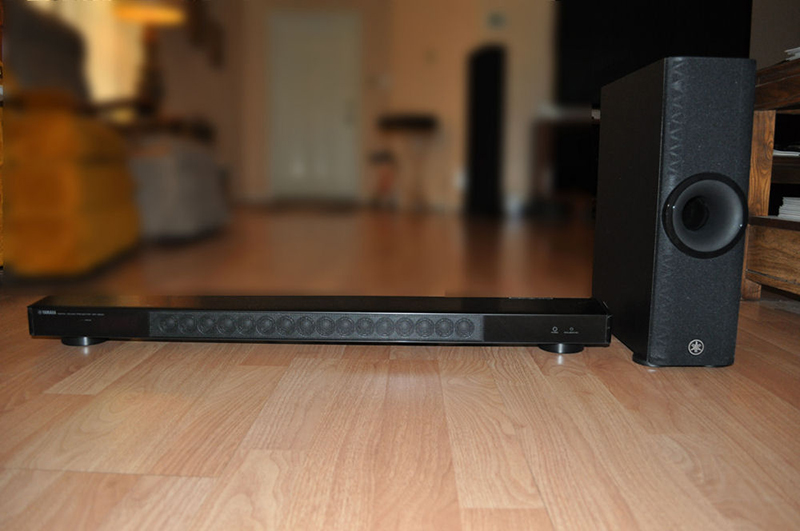
When I first received the YSP-2500, I attempted to install it in my secondary home theater setup in my master bedroom, replacing my AV receiver and LCR speakers, including two floor standing speakers with built-in powered subs, underneath my wall-mounted 65” plasma TV. The system is contained in a small AV credenza and I set the Yamaha on top directly underneath the TV. I did this partly for ease of installation compared to the complexity of my main home theater system and also as I though it offered a fairer comparison (somewhat) to the sound bar.
However, when I ran the Intellibeam room calibration, the bar made it about half way through and then gave out a series of squawks indicating that it was unable to complete the calibration for my main listening position in a recliner over in the corner of the room. I repositioned the mike stand on the recliner and checked all the connections and started the calibration again. The result was the same as before; it was unable to complete the process. The onscreen code indicated that the calibration microphone was not in front of the main unit, despite my having angled the main unit and subwoofer about 30 degrees to fire in the direction of my recliner.
Secrets Sponsor
After much angst and gnashing of teeth, I disconnected the sound bar from everything in my bedroom system and carted the main unit and sub module into my main home theater located in my living room. Again, I set the main unit atop a large AV credenza in front of my 65” plasma TV and connected it to my Samsung DVR, Oppo BDP-103D Blu-ray player and a Western Digital WD TV Live media player using the three HDMI inputs on the Yamaha. I then connected the HDMI output on the YSP-2500 to my TV.
The front of the Yamaha is divided into three main sections: on the left is a nice led screen which can be set to display the input selected, the Intellibeam setting, the decoder being used and the DSP setting. The display can toggled among these displays by the Info button on the remote and also dimmed or turned off. There is also a small bar displaying the volume setting and a green led showing the status. The largest part of the front of the main unit is the sixteen beam drivers (speakers) which are located roughly in the center with the led display on the left and a headphone output and jack for the Intellibeam microphone on the right.
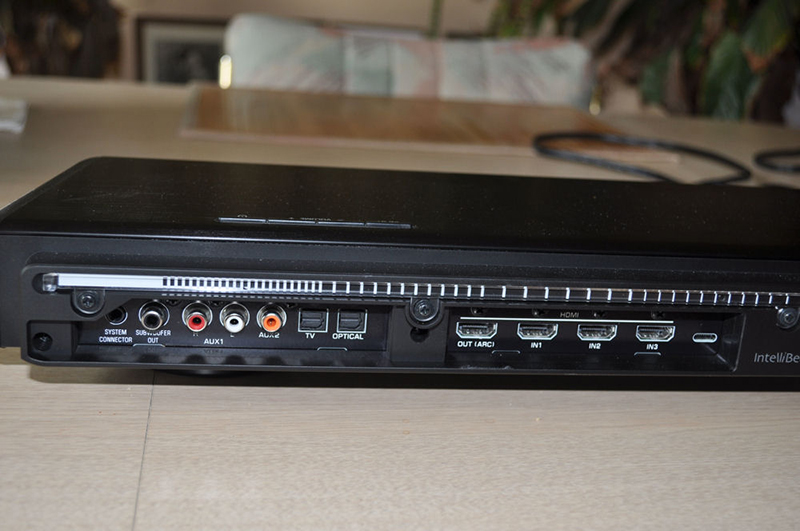
The rear of the main unit has two sections of inputs/outputs. The section on the left has a System Connection which allows the unit to work with other Yamaha gear. Next is a single RCA subwoofer output for use with a non-wireless sub. There follows a pair of analog RCA inputs which could be used to connect a TV which lacks an optical output for sound, and then a digital coaxial input followed by a pair of optical S/PDIF inputs.
Secrets Sponsor
The second section on the rear is comprised of a single HDMI output followed by three HDMI inputs. The output is ARC enabled, allowing one to forgo the optical output from ones TV if the TV has an HDMI input which is ARC capable.
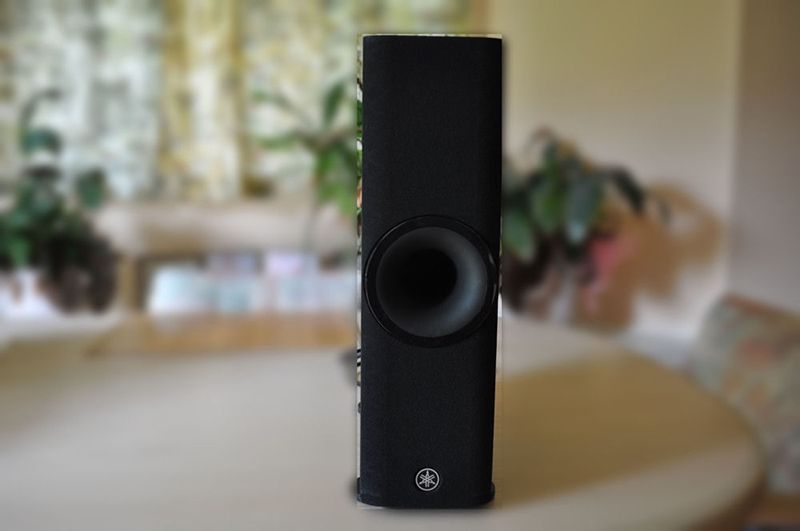
The subwoofer module has no controls, knobs or switches on the front, being covered by a non-removable black grill cloth with a large port in the center. The sub can be positioned either vertically, as I did, or horizontally, but should be positioned to face the listeners since it conveys frequencies higher than typical subs, which could be directional, in addition to the normal frequencies below about 150 Hz, which are non-directional.
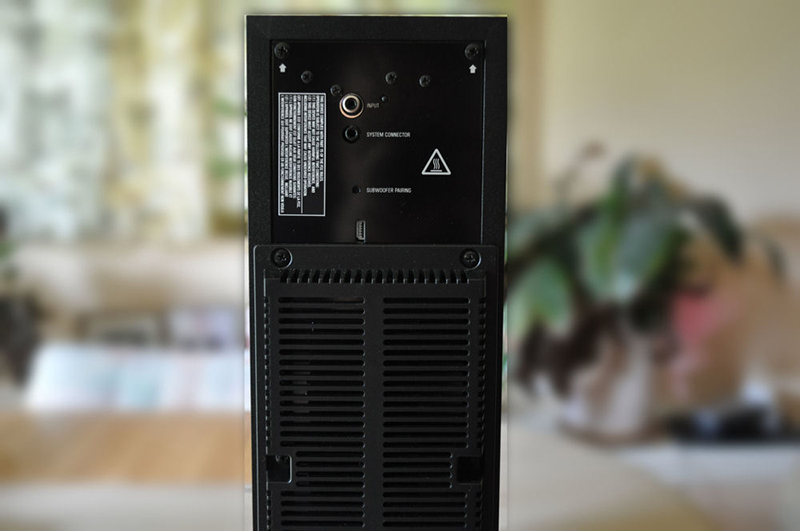
The rear of the sub module has two input jacks, one to mate with the matching System jack on the main unit and a single RCA input to connect the sub to the main unit if, for some reason the wireless connection cannot be used. At the other end of the sub module is the captive power cord.
The Yamaha remote is a slim, solid feeling unit which fits comfortably in one’s hand, but is not backlighted. The remote is quite busy with buttons for nearly every one of the sound bar’s considerable functions and settings. I will not enumerate them all here as I will mention them as they come up further in the course of the review. Suffice it to say, there are a lot of buttons which provide a lot of flexibility for the sound bar, at the expense of added complexity which may be daunting to some users. I do want to single out a couple of the buttons here, however. The remote has a dedicated button to adjust both the level of the subwoofer and another button for adjusting the channel levels. This made it easy to tweak the levels on-the-fly while watching or listening. For example, one might want to bump up the bass a bit for action movies or increase the “rear surround” levels for horror movies and having dedicated buttons on the remote made this quite easy to do without going into the menu or pausing the movie.
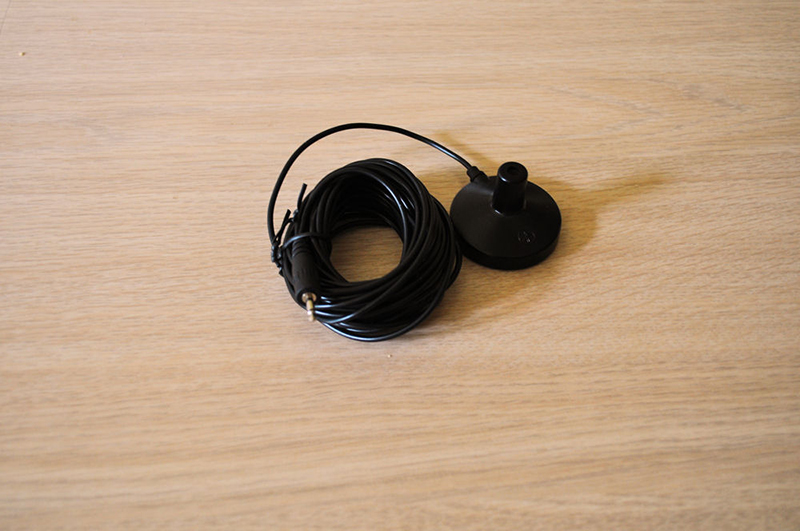
To complete the setup of the Yamaha, I turned on the unit and my television and plugged the subwoofer in to an AC outlet. The small led on the front of the sub blinked for about a minute and then turned a solid green, indicating that the main unit and sub were paired. Next I connected the supplied microphone to the front of the main unit and mounted the mic on my trusty tripod at ear height in my usual listening position. Yamaha supplies a cardboard mic for this purpose, but I did not use it since I am used to my tripod for such calibrations. When I plugged the mic into the main unit, a message appeared on my TV telling me that calibration was about to start when I pressed the Enter button on the remote. Once I did this, another message appeared indicating that I had ten seconds to leave the room, both to avoid the somewhat loud noises and also so as not to interfere with the measurements. After about three minutes of various chirps, hisses and tones, a cheerful sound played informing the process had been successfully completed. To save the calibration setting, one presses one of the three System Memory buttons on the remote, which allows saving multiple calibration settings in different seating locations.
I began my focused viewing and listening by queuing up the Blu-ray of “Edge of Tomorrow” as the opening sequence has some of the lowest and loudest bass I have ever heard in a movie. Although the Yamaha played this part as loudly as expected, it was not able to play these really low frequencies (below 40 Hz), but rather was apparently doubling the fundamental frequency. The net effect was that one still heard a loud, deep bass note, just not the actual frequency being played. The other thing that I noticed immediately was that the Yamaha did not tamper with the beautiful colors and deep blacks of my Panasonic plasma display. This confirms that the sound bar simply passes on the video it is being sent, which is what I always prefer my AV receiver or other device handling the switching to do with video…NOTHING!

Moving on from the brief look/listen to the introduction to Tom Cruse’s movie, I put the HBO miniseries “Band of Brothers” Blu-ray in my Oppo BDP-103D and went to Part 6 covering the famous battle at “Bastogne” France. I quickly discovered that the plentiful shell bursts were quite impactful and the dialogue very clear and easy to follow, something that is key to my enjoyment of any movie. Adding to this episodes bombast, were planes flying overhead dropping bombs during the latter part of this episode, and, again, they were quite realistic sounding within the limitations of preserving one’s hearing and maintaining good relations with the neighbors.
I followed up with another episode from “Band of Brothers”, “Carentan”, and once more the bullets whizzing from every direction sounded quite real. However, as I had noticed in my previous movie viewing, the sense of directionality usually very present in my reference home theater setup was almost totally lacking. With these same movies on my reference system, I was often startled when a bullet flew by my head or a shell crashed beside my listening position. The “surround” effects of the Yamaha are much more diffuse and more like ambient noise, lacking any real directionality.
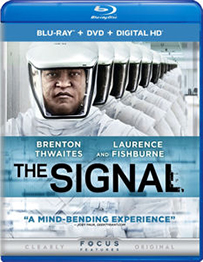
A few days later, I watched the Blu-ray Sci Fi thriller, “The Signal” about a group of interstellar hackers who are discovered by three college friends at MIT. Once more the dialog was easy to follow. Bass sounds were impactful and reasonably deep, but there was little real surround sound, just diffuse ambient sounds. I tried playing with the many settings on the remote such as the four Cinema DSP buttons for Music, Movie, Entertainment, Off.
Each of these buttons has multiple settings for various genres of music, movies and entertainment, but I found that although they did make things sound a bit different as to the frequency balance and also shifting the sound stage slightly to the right or left, they did little to give more of a true surround effect to the sound. In the end, I wound up doing nearly all of my viewing and listening using just the standard Surround button. During this period of experimentation, I also used the Beam button at the top of the remote, but again, all it seemed to do was slightly shift the sound stage or perspective in one direction or the other, so I stuck with the “standard” setting as selected by the calibration program as it seemed to offer the best overall balance. If one’s main listening position is off-center, it is possible that one of the alternate beam settings might prove more satisfactory, but my seat was directly in front of the center of the sound bar.
I wrapped up my movie viewing with two other popular Blu-ray movies, The Avengers “Thor” and “Sin City: A Dame to Kill For”. I won’t go into detail regarding these two movies as they simply confirmed what I have previously stated earlier: the dialogue was always clean and clear and gunshots and explosions were as loud, realistic and impactful one could ever expect given the size of the sound bar and the sub module and the amplifiers powering them. Actually the sound was more impactful than I expected based on the above parameters. Also, as before, there was little real surround sound coming from the virtual left and right rear and back speakers, just diffuse ambience. I believe that the reason for the lack of specific directionality of the surround effects has to do with the layout of my room. I think that in order to get convincing surround sound from a sound bar like the Yamaha, it needs a basically square or rectangular closed room so that it can “steer” sound to reflect off the side and back walls. Unfortunately, in my living room, that is not the case. I have a very long window on the left side wall which is covered with heavy drapes and the right side wall has a fireplace which juts out several feet into the room. Finally, the back wall is only an archway behind my couch and then another large opening into my dining room, so there isn’t much for the sound to reflect off of, at least not in the way that is probably needed for the IntelliBeam to work properly.

Moving on to music listening, I used my WD TV Live streamer to listen to several cuts from Janis Ian’s classic album of teenage angst and loneliness, Between the Lines (16 bit/44.1 flac rip). On my favorite track, “At Seventeen”, Ian’s voice was clear and articulate and located slightly right of center. At first I listened in Stereo mode, but found that the soundstage was just too narrow to be realistic, seemingly confined to the width of the sound bar. I switched to Surround mode and it did widen the apparent soundstage and made the recording sound more realistic.
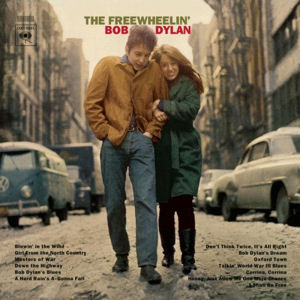
Without really thinking, I next streamed Bob Dylan’s “Blowin’ in The Wind” from his Freewheelin’ Bob Dylan album. I say without thinking, because this album is a 24 bit/192 flac download from HDTracks and I didn’t realize the Yamaha could handle resolutions that high. It never missed a beat and Bob’s somewhat nasal voice sounded just great, but once again, the Stereo mode bunched everything up in the middle, so I switched to Surround mode and was rewarded with a much wider soundstage with the instruments spread across a more reasonable space at the front of the room. Dylan’s biting harmonica notes were especially natural sounding with just enough “bite”. The DAC built into the sound bar surprised me not only with being able to play resolutions this high, but also how good music sounded using it to make the conversion to analog.

For some acoustic guitar, I streamed the David Elias – Acoustic Trio album’s “Ohlone Dream” (DSD download, converted to 24 bit/192 flac). Elias is one of the few artists today who records directly to DSD and his recordings, when played back on a high quality system, can sound “you are there” good. He apparently uses little or no compression with his recordings and because of this they are a good test of a system’s dynamic range and overall realism. I have listened to this track countless times on a number of high quality stereo and surround systems and I must say that Elias’ acoustic guitar was every bit (no pun intended) as full bodied, natural and resonant as compared to those other playback systems.

To conclude my music listening, I switched to a classical album, David Chesky’s, The Zephyrtine: A Ballet Story with the highly dynamic track, “The Monster Comes Down From the Mountains”. This track is the classical version of the tyrannosaurus rex thunderous footsteps in Jurassic Park. While the Yamaha didn’t quite have the impact in the solar plexus that a high end sound system can muster, it was quite dynamic and loud in the appropriate part of the tack. On the other hand, the delicate triangle taps in the quieter section, while clear, did not have the shimmer or “air” of my reference system. I also noted that in a very few occasions, at very high levels, the sound could get a bit shrill, perhaps signaling the onset of clipping in the amps.
YAMAHA YSP-2500 is the Best Build Quality Soundbar
- Doesn’t tamper with video, including 4K Ultra HD
- Excellent build quality
- Lively dynamic sound with good bass output
- Wireless sub
- More consistency in calibration, as calibration may not work in some rooms
- Improved surround sound, especially with Blu-ray movies
- Less dependency on location of sub, which is important as it is somewhat directional
So after spending nearly a month with the Yamaha YSP-2500 sound bar, am I ready to trade in my reference home theater speakers and amps? Honestly, no, and I don’t expect that anyone who has the money, room and willingness to accept the aesthetic trade-offs would either. However, I must say that I was quite impressed with its solid build, tasteful design and dynamic sound. The Yamaha also has an impressive feature set which includes built-in wireless for the sub, built-in Bluetooth aptX streaming, the ability to pass through 4K Utra HD 50/60p video, and decoding for Dolby True HD and DTS-HD Master sound formats and IntelliBeam automatic room calibration.
If I had to rank the three types of use of the Yamaha and how well I felt it handles each of these, I think that ordinary TV listening would be first, followed very closely by music listening and watching Blu-ray movies third. I would have ranked music listening first due to the lively and dynamic nature of its sound, but the sound stage was just too constricted to place it in the top spot.
I suspect that in some rooms, the surround sound might be much more convincing than in my main listening room, but there is really no way to predict that in advance of purchasing the unit and taking it home and trying it out. If hearing Blu-ray movies in full surround mode is important to a potential purchaser, they should buy from a vendor which allows returns if their room configuration does not allow the level of surround effects they desire.
After listening to the Yamaha for a month, I became accustomed to its lively sound and began to wonder if the degree of difference in it and my main theater system was real or just bad memory on my part. So with my review notes complete, I switched everything back to my reference Marantz surround sound processor and Emotiva multi-channel amps powering Definitive Technology BP-8808STS towers, plus the matching center channel as well as Definitive Technology BP-7200 towers in the rear and a single Def. Tech. back surround speaker. I queued up a show in 5.1 Dolby on Netflix and, sure enough, the rear speakers came alive with sounds of creaking doors, telephones in the distance and voices from the other side of the room. So my recollection of the surround levels of my own system compared to the Yamaha were accurate (audio memory is notoriously faulty!).
I would never willingly give up my system for the Yamaha or any sound bar I have ever heard. However, I was certainly impressed on many levels with just how good this sound bar sounds and how full-featured it is; it is basically like a modern AVR with the speakers built-into the same box. If I were in the market for a sound bar, the Yamaha would be at or near the top of my list, so if you cannot fit one of Yamaha’s great AVR’s and separate speakers into your room or your budget, I heartily recommend that you give the Yamaha YSP-2500 an audition.


